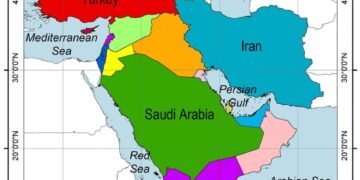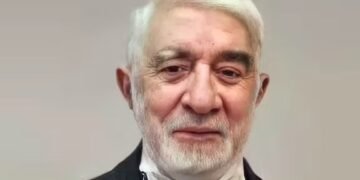Part One
Introduction:
We have often heard discussions about the redrawing of the Middle East map, commonly referred to as the “Greater Middle East” plan, repeatedly mentioned by Israel and the United States. This article will be published in two parts. In the first section, we will discuss geopolitical theories, particularly the Heartland and Rimland concepts developed by Halford Mackinder and Nicholas Spykman, respectively. Finally, we will examine how the U.S. perceives Iran’s strategic position. In the second part, we will delve into how these theories relate to potential changes in the Middle East map and its future trajectory.
A General Look at the Islamic Republic of Iran:
Before analyzing the Heartland theory, we must first understand Iran’s strategic role in global geopolitics. Three main aspects define Iran’s geopolitical position:
- The struggle against Israel.
- Conflicting interests with the West and modernity.
- The shift in Iran’s political ideology based on Shiism, often at odds with national interests.
In Iran, three major ideological perspectives exist:
- A socialist utopian vision.
- The concept of the Islamic Ummah versus nationalism.
- A nationalist perspective focused on Iranian civilization (it is better to use the term “Iranian Plateau” instead of “Iranian Civilization”).
Today, the nationalist perspective is gaining traction among Iranians, challenging the previously dominant Islamic and Shiite ideological framework.
The Emergence of Mackinder’s Heartland Theory:
Alfred Mahan, an American strategist (1840–1914), believed that naval power and control over the seas were essential for global dominance. In contrast, Halford Mackinder, a British scholar (1861–1947), developed the Heartland theory, emphasizing land-based power.
During the 19th century, Britain was the dominant global power, with its empire spanning vast territories. However, emerging rivals such as Germany and Russia posed significant threats. This led British strategists, including Mackinder, to develop new geopolitical frameworks to maintain British supremacy. Mackinder proposed that controlling the Heartland—comprising Eastern Europe, northern Iran, Central Asia, Mongolia, parts of China, and Russia—was the key to global domination.
Mackinder’s Key Concepts:
Mackinder viewed Africa, Europe, and Asia as a single landmass, which he called “Afro-Eurasia” or the “World Island.” He argued that:
- Whoever controls Eastern Europe dominates the Heartland.
- Whoever controls the Heartland dominates Afro-Eurasia.
- Whoever dominates Afro-Eurasia controls the world.
Germany sought to apply Mackinder’s theory during World War II to achieve global dominance but ultimately failed. Similarly, the Soviet Union sought control over Eastern Europe to assert global power.
Why the Heartland (Russia/USSR) Failed to Achieve Sustainable Growth:
- Harsh climatic conditions (cold and dry regions).
- Lack of access to warm-water ports and open seas.
- The vast territory required extensive investment in railways and infrastructure, unlike smaller, more easily navigable countries like Britain.
This lack of economic and political stability hindered the Soviet Union’s long-term dominance.
Spykman’s Rimland Theory:
Nicholas Spykman, an American geographer, expanded on Mackinder’s ideas but shifted the focus to the Rimland—the coastal regions encircling the Heartland. Unlike Mackinder, who argued that controlling the Heartland led to global power, Spykman believed that controlling the Rimland was the key to global dominance.
Why Is the Rimland Important?
- Access to warm waters and open seas.
- Abundant natural resources, including oil and gas.
The Rimland includes:
- All of Europe
- Turkey
- The Iranian Plateau
- The Arabian Peninsula
- Southern China
- India
- The eastern periphery of Russia
The Heartland relies on the Rimland for access to global trade routes and maritime power. The Rimland consists of diverse civilizations, cultures, and economies, making it a dynamic geopolitical space.
The Role of the Rimland During the Cold War:
- The Marshall Plan—U.S. economic support for Europe to counter Soviet influence.
- Turkey’s inclusion in NATO and the CENTO pact—to prevent Soviet access to the Mediterranean.
- The Baghdad Pact—a military alliance between Turkey, Iraq, Iran, and Pakistan to block Soviet expansion into the Persian Gulf.
- The Southeast Asian Treaty Organization (SEATO)—involving the U.S., Britain, France, Australia, the Philippines, Thailand, and Pakistan, leading to U.S. intervention in Vietnam.
- U.S. economic support for China—as a counterbalance to Soviet power.
What Is the U.S. Plan for Iran’s Future?
Before the 1979 revolution, Iran served as the regional gendarme under the Shah. However, the Shah’s growing independence did not align with Western interests. Additionally, the Soviet-backed coup in Afghanistan made Iran a crucial geopolitical link. With the Iranian Revolution, the Soviet Union gained a potential foothold in the region. The U.S. response was to support Islamic movements in Iran and Afghanistan under the “Green Belt” strategy, which aimed to contain Soviet expansion from Afghanistan to Turkey.
Why Did the U.S. Support the Islamic Republic?
- Iran’s revolutionary slogan of “Neither East nor West” aligned with U.S. interests in weakening the Soviet Union.
- The rise of a new ideological framework provided a useful counterbalance to Soviet influence.
Ten years after Iran’s revolution, in 1989, the Soviet Union collapsed.
Factors Leading to the Fall of the Soviet Union (Heartland):
- U.S.-Saudi collaboration under Reagan to lower oil prices, undermining the Soviet economy.
- Increased Soviet military expenditures, straining its resources.
- The “Star Wars” project—a U.S. initiative claiming to develop space-based missile defense. Though largely theoretical, it pressured the Soviet Union into unsustainable military spending.
The Iran-Iraq War and U.S. Interests:
Iraq, a major opponent of Israel, posed a threat to regional stability. In 1982, Israel launched a preemptive strike on Iraq’s nuclear facilities. Initially, the U.S. supported Iraq against post-revolution Iran, which was weakened by international sanctions. However, Iraq later became a regional threat, culminating in its invasion of Kuwait and the subsequent Gulf War, which led to Saddam Hussein’s downfall.
Before the revolution, Iran produced five million barrels of oil per day, controlling 10% of the global market. After 1979, Iran lost its strategic economic position, and U.S. support shifted to Arab Gulf states, making them key regional players. Over time, however, the U.S. reliance on Middle Eastern oil decreased, reducing the importance of Gulf Arab states.
Turkey as a Regional Player:
Turkey’s relationship with the U.S. and the West has become increasingly unstable due to:
- Turkey’s purchase of Russian S-400 missile systems, straining NATO relations.
- Obstructing Sweden and Finland’s NATO accession.
- Intervening in Libya, the Caucasus, and Syria, challenging U.S. regional interests.
These factors have increased Iran’s strategic importance to the West, particularly as the Iranian people generally have pro-Western sentiments, unlike much of the Middle East. This shift has alarmed Arab Gulf states.
The U.S. Strategic Focus:
Currently, the U.S. is prioritizing Eastern Europe and East Asia while maintaining control over the Heartland through the Rimland, with Iran playing a central role.
If the U.S. and Russia reach a settlement over Ukraine, recognizing Russian territorial gains and lifting sanctions, the U.S. may reduce its focus on Iran. Historically, major powers tend to align, making future U.S.-Russia cooperation plausible.
Conclusion:
The U.S. seeks to secure the Rimland and Heartland with minimal military expenditure while shifting focus toward countering China’s rise. Ensuring Iran aligns with Western interests would serve this strategy, stabilizing the Middle East and allowing the U.S. to concentrate on China’s geopolitical challenge.

 English
English






































